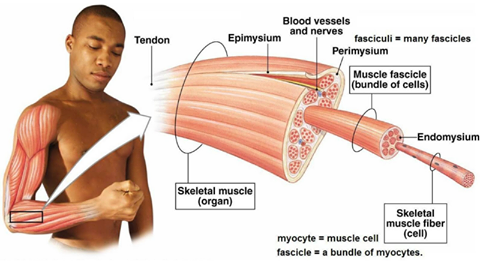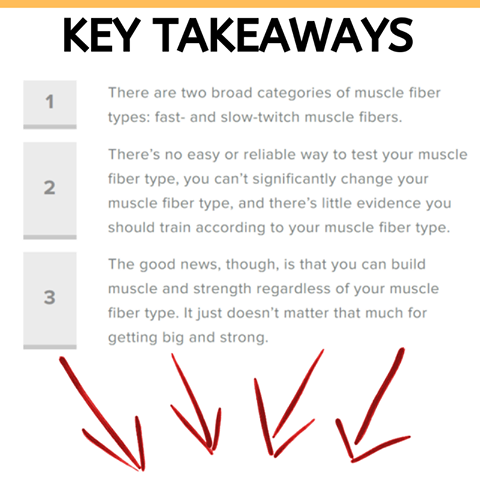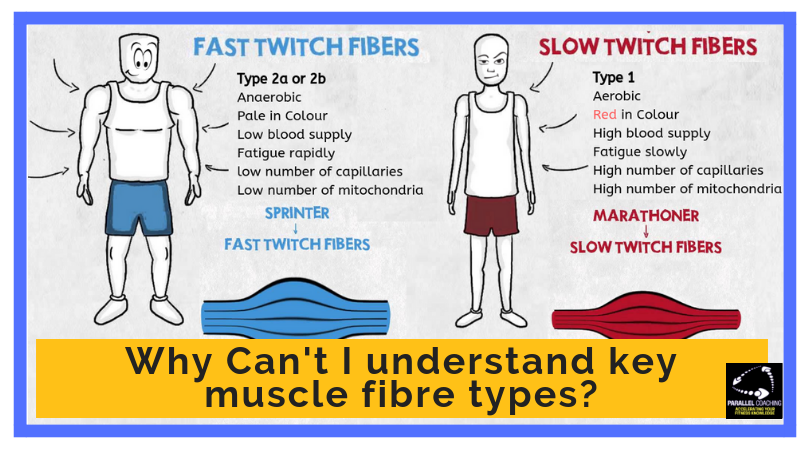Muscles are made of different muscle fibre types and you need to know about these for your Level 2 and Level 3 Anatomy and Physiology Exams.
If you are banging your head against the manual, tired of re-reading paragraphs and struggling to understand the different muscle fibre types, let alone remember all of their characteristics, then you are not alone.
This is one of the areas that is most commonly seen as being “tricky”. In this blog you’ll learn about:
- a muscle fibre,
- what the muscle fibre types are,
- the key characteristics and
- how to apply this knowledge to your training and planning.
[NOTE: 3-5 mins read and answer the mock questions at the bottom]
What is a Muscle Fibre?
A muscle fibre is the same thing as a muscle cell, also known as a myocyte.
Under a microscope, these look like small red or white threads.
Muscle fibres are bound together in bundles forming progressively larger units along with nerves, blood vessels, and various forms of connective tissue, to form a muscle.

Not all muscle fibres are the same, there are different muscle fibre types with different characteristics:
What Are the Muscle Fibre Types?
Generally speaking, muscle fibres are lumped into two categories:
1. Fast-twitch = Type 2a and Type 2b
2. Slow-twitch = Type 1
Let’s go over the main differences.

Six things to know about slow-twitch, or type 1 muscle fibres:
- Slow-twitch fibres contain mitochondria, the organelles that use oxygen to help create adenosine triphosphate (ATP), which is the chemical that actually fuels muscle contractions, and are considered aerobic.
- Slow-twitch fibres are also called red fibres because they contain more blood-carrying myoglobin, which creates a darker appearance.
- Because they can provide their own source of energy, slow-twitch fibres can sustain force for an extended period of time, but they are not able to generate a significant amount of force.
- Slow-twitch fibres have a low activation threshold, meaning they are the first recruited when a muscle contracts. If they can’t generate the amount of force necessary for the specific activity, the fast-twitch muscle fibres are engaged.
- . The tonic muscles responsible for maintaining posture have a higher density of slow-twitch fibres.
- Steady-state endurance training can help increase mitochondrial density, which improves the efficiency of how the body uses oxygen to produce ATP.
As you can see, slow-twitch fibres have specific characteristics for how they function, which means they can be trained to be more aerobically efficient with the proper exercise program.
Techniques for training slow-twitch fibres:
- Exercises that feature sustained isometric contractions with little-to-no joint movement keep the slow-twitch muscle fibres under contraction for an extended period of time. This can help improve their ability to utilize oxygen to produce energy. Examples include a plank core exercise.
- Resistance-training exercises using lighter weights with slower movement tempos for higher numbers of repetitions (i.e., more than 15) can engage the slow-twitch fibres to use aerobic metabolism to fuel the activity.
- Circuit training, which involves alternating from one exercise to the next with little-to-no rest while using lighter weights, can be an effective way to challenge slow-twitch fibres.
- Body-weight exercises for higher numbers of repetitions can be an effective way to challenge aerobic metabolism, which helps improve the efficiency of slow-twitch fibres.
- When working with body-weight only or lighter amounts of resistance, use shorter rest intervals of approximately 30 seconds between sets to challenge the slow-twitch fibres to use aerobic metabolism to fuel the workout.
6 things to know about fast-twitch, or type 2 muscle fibres:
- Fast-twitch fibres can be further classified into (1) fast-twitch IIa – fast oxidative glycolytic, because they use oxygen to help convert glycogen to ATP, and (2) fast-twitch type IIb – fast glycolytic, which rely on ATP stored in the muscle cell to generate energy.
- The Fast-twitch fibres have a high threshold and will be recruited or activated only when the force demands are greater than the slow-twitch fibres can meet. Fast-twitch fibres can generate more force, but are quicker to fatigue when compared to slow-twitch fibres.
- The larger fast-twitch fibres take a shorter time to reach peak force and can generate higher amounts of force than slow-twitch fibres.
- Strength and power training can increase the number of fast-twitch muscle fibres recruited for a specific movement.
- Fast-twitch fibres are responsible for the size and definition of a particular muscle.
- Fast-twitch fibres are called “white fibres” because do not contain much blood, which gives them a lighter appearance than slow-twitch fibres.
As you can see, the characteristics of fast-twitch fibres are more suited for explosive, strength-and power-based sports.
If you want to engage more fast-twitch fibres to help you increase strength levels or become more explosive, here are a few specific techniques that work.
Techniques for engaging fast-twitch fibres:
- Resistance training with heavyweight stimulates muscle motor units to activate more muscle fibres. The heavier the weight, the greater the number of fast-twitch fibres will be recruited.
- Performing explosive, power-based movements, whether it is with a barbell, kettlebell, medicine ball or simply your own body weight, will recruit greater levels of fast-twitch fibres.
- Fast-twitch fibres will fatigue quickly, so focus on using heavyweight or explosive movements for only a limited number of repetitions (e.g., two to six) for maximum effectiveness.
- Because they deplete energy quickly, fast-twitch fibres require longer rest periods to allow motor units to recover and to replace spent ATP. Therefore, allow at least 60 to 90 seconds of rest after each explosive or strength exercise.

Understanding how anatomy and physiology of the body adapts to exercise can help you develop more effective exercise programs for your clients specific needs.
Genetics determines how much of each muscle-fibre type you possess
However, identifying whether you are fast- or slow-twitch dominant would require an invasive muscle biopsy.
Therefore, if you find that you tend to enjoy more endurance-based activities and that they are relatively easy for you, you probably have a greater number of slow-twitch fibres.
Conversely, if you really dislike going for long runs, but enjoy playing sports that rely on short bursts of explosive movements, or if you like weight training because it is relatively easy, you are probably fast-twitch fibre dominant.
An exercise program that applies the right training strategies for your muscle fibres can help you to maximize the efficiency and enjoyment of your workout time.
To test your knowledge scroll to the bottom of this blog for 3 Quiz Questions all about Muscle Fibre Types:
Before you start learning and revising, it is best to find out where your knowledge is right now. For this, we have prepared 48 mock questions for you to download.
These are mapped to the Active IQ Level 3 Anatomy and Physiology exam and other awarding bodies, so you know it is a clear reflection of your current ability. We have divided the 48 mock questions into sections so you can clearly see which areas are your stronger and weaker areas of knowledge. DOWNLOAD THE 48 MOCK QUESTIONS HERE
If you are struggling with understanding what are the three energy systems, as well as other parts of your anatomy revision then join 6500 learners who have passed their exams with confidence using our Level 3 Anatomy and Physiology Revision Mastery Bootcamp.

Muscle Fibre Types Mock Questions:
[NOTE: The answers are below the 3rd question]
1. What are the characteristics of Type 2b muscle fibres?
A. High force capacity, low mitochondria and low capillary density
B. High force capacity, high mitochondria and low capillary density
C. High force capacity, low mitochondria and high capillary density
D. Low force capacity, high mitochondria and high capillary density
2. What effect will long-term strength training have on type 2 muscle fibres?
A. Hyperplasia
B. Atrophy
C. Hypertrophy
D. Articulation
3. Which of the following statements about type 1 muscle fibres is true?
A. They are slower to fatigue than type 2
B. They have few mitochondria
C. They utilise the anaerobic energy system
D. They are white in colour
Download More Mock Questions for FREE just link these by clicking this link: MOCK QUESTIONS

Answers:
Mock Question Answers:
Question 1= A, Question 2 = C, Question 3 = A
Dedicated to More
Parallel Coaching
P.S. You can also find us on the following platforms:
Instagram: https://www.instagram.com/parallelcoaching
Facebook: https://www.facebook.com/ParallelCoaching
Twitter: https://twitter.com/ParallelCoach
YouTube: http://bit.ly/2F1Z1bs

